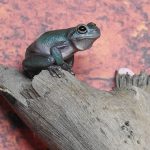CAVE-DWELLING FROG
The Cave-Dwelling Frog
Deep within the limestone caves of Australia’s Kimberley region, a remarkable amphibian thrives: the cave-dwelling frog (Ranoidea cavernicola). This species, also known as the cave frog, has adapted uniquely to its subterranean environment.
Physical Characteristics
- Size and Appearance: Adult cave-dwelling frogs reach up to 6 cm in length. They possess a green or green-brown dorsal coloration, occasionally transitioning to brown, with a contrasting white belly. Their large, horizontally elliptical pupils and gold irises enhance their vision in low-light conditions. The fingers are slightly webbed, and the toes are three-quarters webbed, both featuring large discs that aid in climbing. (frogid.net.au)
Habitat and Distribution
Geographical Range: Endemic to Australia, these frogs are found exclusively in the Kimberley region of Western Australia, from the Mitchell Plateau south and west to the Prince Regent River Nature Reserve, and also on Bigge Island and Katers Island.
Preferred Environment: They inhabit limestone caves and rocky outcrops, environments that offer a cool, moist refuge from the arid climate of the surrounding landscape.
Behaviour and Diet
Feeding Habits: Cave-dwelling frogs primarily consume small insects and other invertebrates. They rely on their keen senses of sight and touch to navigate the dimly lit caves, capturing prey with their quick, sticky tongues.
Breeding: Breeding occurs during the wet season when conditions are more favourable. Females lay eggs in small pools of water within the caves. These eggs hatch into tadpoles, which develop into adult frogs over approximately one month. (frogid.net.au)
Conservation Status
- Threats and Conservation: The cave-dwelling frog is currently listed as “Data Deficient” by the IUCN Red List, indicating that there is insufficient information to assess its conservation status. Its reliance on specific cave habitats makes it particularly vulnerable to environmental changes, highlighting the importance of conserving these unique ecosystems.
Interesting Facts
Adaptations: The cave-dwelling frog’s large eyes are adapted to low-light conditions, aiding in navigation and prey capture within the caves.
Ecological Role: As a predator of invertebrates, this frog plays a crucial role in controlling insect populations within its cave ecosystem.
Conservation Importance: The species’ limited distribution and specialized habitat underscore the need for targeted conservation efforts to protect these unique cave ecosystems.
The cave-dwelling frog exemplifies the resilience and adaptability of Australian wildlife, thriving in one of the most unique and challenging environments on the planet.

